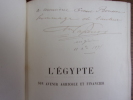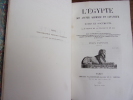5 books for « paponot f n g »Edit
-
Topics
Agriculture (1)
Egypt (1)
Explorations (1)
History (1)
Travel (2)
-
Syndicate
ILAB (2)
SLAM (2)
Canal interocéanique de Panama. Essai sur la reprise des travaux.
Paris, Baudry & Cie, 1894. 1894 1 vol grand in-8° (255 x 165 mm) en deux parties de: [2] ff (ft, t), 53 pp, [1] f (table ; [2] ff (ft, t), 156 pp, dont un graphique et une table, 1 planche dépliante. Envoi manuscrit signé de lauteur « à Mr Bouillet » sur la page de faux titre. Exemplaire à toutes marges, non rogné. Demi-maroquin rouge à coins d'époque, dos à nerfs orné et titré à l'or, plats recouverts de papier marbré, tranche supérieure dorée, corps d'ouvrage à toutes marges, non rogné. (Épidermures et défauts d'usage).
Très rare publication due à Félix Nicolas Gilbert Paponot, (1835-1897), véritable plaidoyer pour une reprise des travaux de percement de lIsthme de Panama alors à larrêt par suite de la déconfiture financière du projet. Félix Paponot, est lun des acteurs majeurs de la construction du Canal de Suez. Formé au métier de dessinateur puis darchitecte, il est embauché en 1860 par lentreprise Hardon, chargée par la Compagnie du canal maritime de Suez dexécuter les travaux de percement de listhme. Puis en 1863, il est recruté par la Compagnie de Suez. Il gravit les échelons de la hiérarchie et devient chef de section. En 1869, après son inauguration, Soutenu par Ferdinand de Lesseps, Paponot crée alors sa propre entreprise de travaux publics afin de sengager dans le grand chantier de percement du canal deau douce du Caire à Ismaïlia, qui comprend la réalisation de gigantesques terrassements et la construction des ouvrages dart associés (ponts et écluses). Le succès du canal de Suez permet la mise en chantier dun second canal transocéanique : Le percement dun canal traversant l'isthme de Panama, dont les travaux commencent en 1881. Cette première tentative entraîne de nombreuses pertes en vies humaines causées par des maladies, mais ce sont des difficultés financières et techniques qui mettent fin au projet en 1889 et conduisent aux scandales de l'"affaire de Panama". En 1888, avant larrêt du chantier, Paponot fait paraitre un premier mémoire intitulé « Achèvement du Canal de Panama. Etude technique et financière ». 5 ans plus tard, espérant peser sur une possible reprise il publie « Canal interocéanique de Panama. Essai sur la reprise des travaux », étude plus poussée et argumentée. Lingénieur, fort du prestige quil a acquis sur les chantiers du canal de Suez, espère relancer le projet Français et convaincre de nouveaux investisseurs. Son ouvrage, dont le titre porte la citation de Jules Ferry « Ne laissons pas passer l'histoire et se faire les destinées du monde à côté de la France, sans elle et contre elle », sarticule en deux parties : description sommaire. Historique, pièces justificatives, plans et profils. La préface débute par lindignation de lauteur de voir les travaux à larrêt « Douze cent cinquante millions de notre épargne nationale apportés par la classe la plus modeste, celle qui fait notre force comme notre orgueil, ont été dépensés au service d'une uvre humanitaire et universelle, le Canal de Panama; et cependant, malgré cette grosse dépense et les huit années d'excessif labeur pendant lesquelles se sont produits tant de dévouements et tant de travaux également, la Compagnie a échoué et, depuis plus de cinq ans déjà, cette uvre reste inachevée !!! Pourquoi ce regrettable arrêt et pourquoi ce long statu quo ? Y a-t-il vraiment un obstacle insurmontable à l'exécution de cette uvre, et devons-nous reculer...? alors que le liquidateur lui-même en juillet 1892 faisait cette mémorable et consolante déclaration dans le traité Hiélard, où après avoir détaillé l'importante situation, démontre la valeur considérable de l'actif dans la reprise, la honte et la ruine dans l'abandon terminait ainsi. « Est-ce à dire qu'il soit impossible de réparer le dommage, de conjurer la ruine ? Nous ne le pensons pas. Nous affirmons au contraire que tout peut être sauvé encore, si nous réussissons à faire partager au public, aux intéressés, l'ardente conviction qui nous anime, et qui justifie le pressant appel que nous venons leur adresser. » Les voeux de Paponot sont en partie exhaussé : Limpact désastreux du « scandale de Panama » empêche une reprise du chantier par les français, mais le projet est repris par les États-Unis et qui achèvent les travaux en 1914. 2 planches, dont 1 dépliante, illustrent louvrage, donnant : I « Profil en long du canal dressé avec les surfaces pour ordonnées » ; II. « Canal interocéanique de Colon à Panama. Profil en long avec figuration du projet par bief éclusé. Plan général ». Bel exemplaire, très frais et non rogné, conservé dans sa reliure dorigine. 1 large 8vo (255 x 165 mm) in two parts of : [2] ff (ft, t), 53 pp, [1] f (table; [2] ff (ft, t), 156 pp , including a graph and a table, 1 folding plate signed by the author "to Mr Bouillet" on the false title page Copy with all margins, half red morocco with period corners. with ribs decorated and titled in gold, boards covered with marbled paper, gilded upper edge, body of work with all margins, untrimmed (Scratches and defects of use). Very rare publication due to Félix Nicolas Gilbert Paponot, (1835-1897), a real plea for a resumption of the drilling work on the Isthmus of Panama then at a standstill following the financial collapse of the project. Félix Paponot is one of the major players in the construction of the Suez Canal. Trained as a draftsman and then as an architect, he was hired in 1860 by the Hardon company, commissioned by the Suez Maritime Canal Company to carry out the work of drilling the isthmus. Then in 1863, he was recruited by the Suez Company. He climbs the hierarchy and becomes section head. In 1869, after its inauguration, Supported by Ferdinand de Lesseps, Paponot then created his own public works company in order to engage in the large construction site of the fresh water canal from Cairo to Ismailia, which included the construction of gigantic earthworks and the construction of associated engineering structures (bridges and locks). The success of the Suez Canal allowed the start of construction on a second transoceanic canal : The drilling of a canal crossing the Isthmus of Panama, work that began in 1881. This first attempt resulted in numerous losses of human life by illnesses, but it was financial and technical difficulties which put an end to the project in 1889 and led to the scandals of the Panama affair. In 1888, before the construction site was stopped, Paponot published a first memoir entitled Completion of the Panama Canal. Technical and financial study. 5 years later, hoping to influence a possible recovery, he published Panama Interoceanic Canal. Essay on the resumption of work, more in-depth and argued study. The engineer, with the prestige he acquired on the Suez Canal construction sites, hopes to relaunch the French project and convince new investors. His work, whose title bears the quote from Jules Ferry Let us not let history pass and make the destinies of the world alongside France, without it and against it, is divided into two parts : summary description. History, supporting documents, plans and profiles. The preface begins with the author's indignation at seeing the work stopped: Twelve hundred and fifty million of our national savings brought by the most modest class, those who make up our strength and our pride, were spent in the service of a humanitarian and universal work, the Panama Canal; and yet, despite this great expense and the eight years of excessive labor during which so much dedication and so much work was produced, the Company failed and, for more than five years already, this work has remained unfinished!!! Why this regrettable stop and why this long status quo? Is there really an insurmountable obstacle to the execution of this work, and must we step back...? while the liquidator himself in July 1892 made this memorable and consoling declaration in the Hiélard treatise, where after detailing the important situation, demonstrates the considerable value of the assets in the recovery, the shame and ruin in the abandonment ended like this. Does this mean that it is impossible to repair the damage, to ward off ruin? We do not think so. On the contrary, we affirm that everything can still be saved, if we succeed in sharing with the public, with those concerned, the ardent conviction which animates us, and which justifies the pressing appeal which we have come to address to them. » Paponot's wishes were partly fulfilled: The disastrous impact of the "Panama scandal" prevented the French from taking over the site, but the project was taken over by the United States and they completed the work in 1914. 2 plates, including 1 folding, illustrate the work, giving: I Long profile of the canal drawn up with the surfaces for ordinates; II. Interoceanic Canal from Colon to Panama. Long profile with representation of the project by lock reach. General plan ". Beautiful copy, very fresh and untrimmed, preserved in its original binding.
L’ÉGYPTE
L’ÉGYPTE son avenir agricole et financier. Notes et documents sur la richesse et la fécondité du sol suivis d'une nouvelle étude sur les irrigations avec description des travaux à faire et indication des moyens d'y parvenir complétée par l'exposé du projet de canal d'Ismaïlia à Port-Saïd le Tewfickieh Félix Paponot ( Ingénieur ) Bel et rare envoi de l'auteur en page de garde ( 1897 ) vol relié, 250x160, demi cuir à coins, superbe reliure, toutes tranches dorées, 236pp, bel et rare exemplaire ! Complet de ses 19 planches hors texte dépliantes Paris. Librairie Polytechnique Baudry et Cie. 1844.
Egypte, son avenir agricole et financier. Notes et documents sur la richesse et la fécondité du sol.
<p>Suivi d'une nouvelle Etude sur les irrigations avec description des travaux à faire et indication des moyens d'y parvenir complété par l'Exposé du projet de canal d'Ismaïlia à Port-Saïd le Tewfickieh. </p> Paris, 1884 240 p., XIX planches, demi reliure (trace d'humidité sur le bas des pages). 16 x 24
Occasion
L'Egypte, son avenir agricole et financier : Notes et documents sur la richesse et la fécondité du sol
Librairie Polytechnique Baudry et Cie Broché 1884 In-8 (16,5 x 24,5 cm), broché, VI-240 pages ; dos fendu recollé, réparations et manques sur les bords des plats, en l'état. Livraison a domicile (La Poste) ou en Mondial Relay sur simple demande.
L'Égypte son avenir agricole et financier. Notes et documents sur la richesse et la fécondité du sol suivis d'une nouvelle étude sur les irrigations avec description des travaux à faire et indication des moyens d'y parvenir complétée par l'exposé du projet de canal d'Ismaïlia à Port-Saïd le Tewfickieh. Paris. Librairie Polytechnique Baudry et Cie. 1844.
1 volume in-8° broché, VI + 240 p. - 18 planches hors-texte. Une petite déchirure sans manque au plat inférieur sinon très bon état etq uelques petites rousseurs sinon très bon état. Rare.
Phone number : 06.31.29.75.65
 Write to the booksellers
Write to the booksellers







